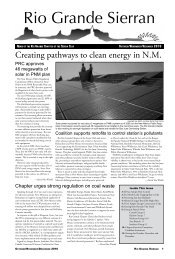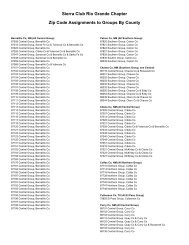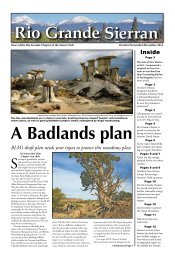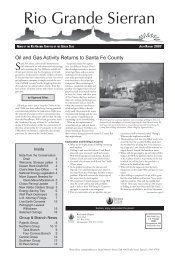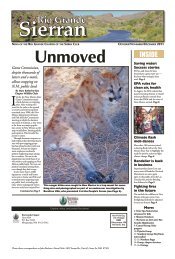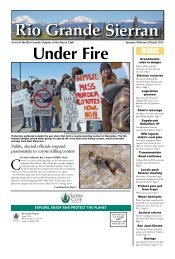Choosing pollution Your photo - Rio Grande Chapter
Choosing pollution Your photo - Rio Grande Chapter
Choosing pollution Your photo - Rio Grande Chapter
Create successful ePaper yourself
Turn your PDF publications into a flip-book with our unique Google optimized e-Paper software.
How will climate change affect N.M.<br />
By Mona Blaber<br />
Every study released lately<br />
seems to have worse news<br />
about climate change, but it’s<br />
hard to translate the figures<br />
and statistics into any kind of idea of<br />
how life will change in New Mexico,<br />
or any region, in the coming decades. I<br />
asked University of New Mexico Earth<br />
and Planetary Sciences professor David<br />
Gutzler, who has researched climate<br />
variability in the West, about what<br />
these predictions mean for us.<br />
Question: In October, a National<br />
Center for Atmospheric Research<br />
study predicted worse-than-Dust Bowl<br />
droughts, unprecedented drought, by the<br />
2060s and earlier in the Southwest (and<br />
many other regions), even under moderate<br />
emissions scenarios. Does that study<br />
seem in line with research you’ve done<br />
Gutzler: Yes indeed. Tessia Robbins,<br />
one of our star undergrads at UNM,<br />
and I published a paper last year on<br />
projected droughts in the western US.<br />
Consistent with Aiguo’s (NCAR scientist<br />
Aiguo Dai) research, we find that<br />
the climate projections generated using<br />
a moderate greenhouse-gas-concentration<br />
scenario put the SW into a temperature<br />
regime outside the historical<br />
(20th century) range of variability by<br />
the latter half of this century. That rate<br />
of temperature increase drives Palmer<br />
Drought Index values into the “severe<br />
drought” category as the new climatic<br />
normal across the Southwest, by increasing<br />
evaporation off the surface.<br />
Q: I hear about Dust Bowl conditions,<br />
and much of New Mexico and<br />
Texas is currently in extreme drought.<br />
Could conditions for farmers here be<br />
similar to the Dust Bowl in the next few<br />
decades What changes can they expect<br />
A: Meteorological conditions are<br />
projected to trend toward those seen<br />
in the 1930s, or the 1950s in AZ and<br />
NM. However we need to be careful<br />
with terms like “Dust Bowl,” because<br />
land-management practices contributed<br />
substantially to that terrible event.<br />
As a society we should anticipate<br />
the high likelihood of much warmer<br />
temperatures, combined with decadal<br />
episodes of reduced precipitation, and<br />
make sure that we don’t repeat the<br />
land-management mistakes of the past.<br />
Q: How would these drought<br />
conditions affect urban New Mexico<br />
residents<br />
A: Urban residents around here in<br />
the 20th century were buffered from<br />
drought because cities largely (or<br />
completely) pumped groundwater<br />
for municipal usage. Our cities are<br />
now more vulnerable to drought, in<br />
three ways: (1) we know that in many<br />
places groundwater has been considerably<br />
depleted, so our buffer has been<br />
mined; (2) cities in the Southwest<br />
have many more people ... the huge<br />
growth in urban population took<br />
place largely during several decades of<br />
anomalously high-precip years in the<br />
late 20th century; (3) as noted above,<br />
climate is trending toward warmer<br />
temperatures and more severe drought,<br />
making surface-water supplies more<br />
problematic right at the time when cities<br />
such as Albuquerque and Santa Fe<br />
are moving (at great expense) toward<br />
surface-water consumption. Note that<br />
only the last of the three reasons for<br />
increased water-supply vulnerability<br />
cited here is directly climate-related!<br />
Climate change is simply amplifying<br />
the increased vulnerability to water<br />
shortage that exists here anyway.<br />
Q: We are still breathing smoke<br />
from the wildfire that started in Arizona,<br />
and the winds this spring seemed<br />
especially heavy and constant. Can we<br />
expect more and more of these conditions<br />
as the years pass<br />
A: Yes, increased wildfire activity is<br />
among the more confident projections<br />
we can make. The spring season, in<br />
particular—that’s wildfire season here,<br />
as everyone now realizes if they didn’t<br />
know it before this year—exhibits<br />
sharply rising temperatures and decreasing<br />
soil moisture in the Southwest.<br />
That’s in the data record now, not just a<br />
hypothetical projection from a model.<br />
Coming at the end of a century of active<br />
fire suppression that increased forest fuel<br />
density, these conditions are conducive<br />
to explosive fire this time of year.<br />
Q: What can we do to prepare<br />
What can we do to prevent Or do you<br />
think it’s too late to stop warming, and<br />
we should concentrate on adapting<br />
A: Why set up a choice between<br />
preparation and prevention Aren’t we<br />
smart enough to consider both<br />
One big difference between preparation<br />
and prevention (in climate research<br />
jargon, we call these approaches<br />
“adaptation” and “mitigation,” respectively)<br />
is that many potential aspects of<br />
adaptation can take place at the local<br />
scale, such as the measures adopted<br />
recently by the city of Chicago. Costs<br />
and benefits are easier to assess at the<br />
local level. That’s why the Clean Air<br />
Act applied to local air <strong>pollution</strong> works<br />
effectively—citizens can make a direct<br />
connection between whatever costs and<br />
hassles they incur, and the resulting<br />
improvement in local air quality.<br />
Effective mitigation of greenhouse<br />
gas emissions must be coordinated<br />
internationally, and politically that’s<br />
much more difficult to implement. As<br />
we’ve seen, international mitigation<br />
efforts such as the Kyoto Protocol have<br />
so far failed completely, and discussion<br />
of a successor policy at the international<br />
level is paralyzed because nobody<br />
wants to be the first to implement a<br />
meaningful emissions reduction strategy.<br />
The argument for going first has to<br />
be based on the opportunity to become<br />
a leader in development of new energy<br />
sources. The New Mexico Environmental<br />
Improvement Board approved a pair<br />
of state policies last year based on that<br />
argument. It’s obviously controversial.<br />
The new administration in Santa Fe is<br />
working to overturn the policies.<br />
CCAE: PNM fossil-fuel investments drive rate increases<br />
By David Van Winkle<br />
“PNM is currently seeking to raise its rates well<br />
over $100 million per year, the largest increase in<br />
New Mexico history. At the same time, PNM is<br />
not doing nearly enough to mitigate this and future<br />
proposed rate increases driven by its continued<br />
investment in old, dirty fossil-fuel power plants,”<br />
Don Hancock, Chairman of the Coalition for Clean<br />
Affordable Energy, said in April of proposed PNM<br />
rate hikes.<br />
PNM proposes a rate increase of a total of $156<br />
million/year by 2013, a 20 percent jump in bills for<br />
customers. PNM had already raised electricity rates<br />
by 25 percent in the past few years due to investments<br />
in fossil-fuel infrastructure. Thus, PNM rates<br />
From “Climate variability and projected change in the western U.S.,” Gutzler/Robbins<br />
Palmer Drought Index averages for the West using actual figures<br />
through 2007 and projections for a mid-range emissions<br />
scenario. “0” represents normal moisture conditions; negative<br />
is drier. Minus-3, now considered severe drought, would be<br />
average conditions for much of New Mexico after 2050.<br />
will have increased 50 percent (1.25 x 1.20 = 1.50)<br />
in just a few years. New Mexico ratepayers would<br />
be better served by a more much aggressive implementation<br />
of energy efficiency and clean renewable<br />
energy, says CCAE.<br />
PNM’s proposed rate increase includes fossil-fuelbased<br />
cost increases of $105 million (with $85 million<br />
implemented between now and January 2012,<br />
plus another $20 million in January 2013). Thus,<br />
electricity rates will have increased by 41 percent<br />
from fossil-fuel investments alone. And this does not<br />
include hundreds of millions already spent on those<br />
plants and charged to PNM customers.<br />
However, by 2013, PNM’s planned investment in<br />
energy efficiency is only $27 million and renewable<br />
energy only $24 million, an almost trivial amount in<br />
relation to PNM’s $1 billion cost of service. This under-investment<br />
in new technology will cause ratepayer<br />
problems for the foreseeable future unless corrected<br />
by a more aggressive plan by the company in energy<br />
efficiency and clean energy.<br />
“Investments in energy efficiency save ratepayers<br />
money,” Tom Singer of Natural Resources Defense<br />
Council said. “It is well known in the utility industry<br />
that investments in energy efficiency are at least 50<br />
percent cheaper than building new energy sources,<br />
such as power plants and transmission lines. We<br />
encourage PNM and the Public Regulation Commission<br />
to adopt more aggressive energy-efficiency<br />
measures to stop this upward spiral of rate increases.”<br />
8 <strong>Rio</strong> <strong>Grande</strong> Sierran July/August/September 2011



